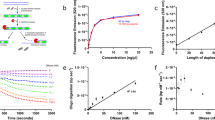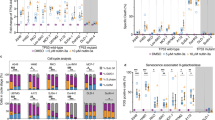Abstract
Cytotoxic T lymphocytes, and other death-inducing agents, have at least two different ways of killing their targets: drilling holes in the target cell membrane, or triggering the targets to commit suicide. The JAM Test is a method that measures the DNA fragmentation that accompanies cell suicide. We label target cells with radioactive DNA-precursor nucleotides and harvest them onto fiberglass filters, which trap large pieces of DNA but pass smaller fragments of apoptotic cells. As a general measure of apoptosis, the JAM Test described here is faster (can be completed in 4 h [or less if labeling is done the night before]), more quantitative, easier, more sensitive, more flexible and cheaper than most other current assays of apoptosis. The P-JAM, also discussed, additionally allows for assessment of death in cells that don't fragment their DNA, and allows for assays of agents that induce cell stasis rather than death.
This is a preview of subscription content, access via your institution
Access options
Subscribe to this journal
Receive 12 print issues and online access
$259.00 per year
only $21.58 per issue
Buy this article
- Purchase on Springer Link
- Instant access to full article PDF
Prices may be subject to local taxes which are calculated during checkout




Similar content being viewed by others

References
Matzinger, P. The JAM test. A simple assay for DNA fragmentation and cell death. J. Immunol. Methods 145, 185–192 (1991).
D'Adamio, L. et al. Negative selection of thymocytes. A novel polymerase chain reaction-based molecular analysis detects requirements for macromolecular synthesis. J. Immunol. 149, 3550–3553 (1992).
Böhm, C. et al. A modification of the JAM test is necessary for a correct determination of apoptosis induced by FasL+ adherent tumor cells. J. Immunol. Methods 217, 71–78 (1998).
Ayres, F.M. et al. A comparative study of the JAM test and 51Cr-release assay to assess the cytotoxicity of dendritic cells on hematopoietic tumor cells. Immunol. Invest. 32, 219–227 (2003).
van Genderen, H. et al. In vitro measurement of cell death with the annexin A5 affinity assay. Nat. Protocols 1 (doi:10.1038/nprot.2006.55) (2006).
Hoves, S. et al. The JAM-assay: optimized conditions to determine death-receptor-mediated apoptosis. Methods 31, 127–134 (2003).
Acknowledgements
We would like to thank the numerous people who, over the years, asked questions, sent suggestions, and shared their successes and failures with the JAM Test. This research was supported by the Intramural Research Program of the NIAID, NIH.
Author information
Authors and Affiliations
Corresponding author
Ethics declarations
Competing interests
The authors declare no competing financial interests.
Rights and permissions
About this article
Cite this article
Usharauli, D., Perez-Diez, A. & Matzinger, P. The JAM Test and its daughter P-JAM: simple tests of DNA fragmentation to measure cell death and stasis. Nat Protoc 1, 672–682 (2006). https://doi.org/10.1038/nprot.2006.107
Published:
Issue Date:
DOI: https://doi.org/10.1038/nprot.2006.107
This article is cited by
-
Abalone visceral extract inhibit tumor growth and metastasis by modulating Cox-2 levels and CD8+ T cell activity
BMC Complementary and Alternative Medicine (2010)
Comments
By submitting a comment you agree to abide by our Terms and Community Guidelines. If you find something abusive or that does not comply with our terms or guidelines please flag it as inappropriate.


